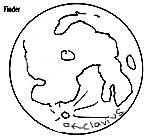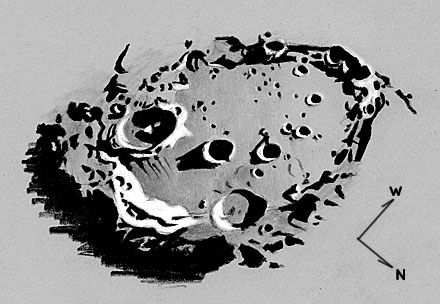Move mouse over image to view labels. Lettered craters are Clavius labels, unless otherwise noted.
Observation Notes:
 The craterlet pattern in this larger crater is amazing. The floor of Clavius was smooth overall and shaded nicely from light to dark in the setting sunlight. A number of ravines ran north from Rutherfurd crater. Crater Clavius CB sat astride what appeared to be a smooth mound or dome. Besides Rutherfurd and Porter Craters, I spotted at least 32 craters on the floor of Clavius. The smallest was just east of Clavius N that turned out to be 3 km (2 miles) in diameter. I should note that I sketched Clavius JA about 2 times larger than I should have. It was actually smaller than Clavius J...I noticed that as I worked on the sketch, but didn't get around to correcting it.
The craterlet pattern in this larger crater is amazing. The floor of Clavius was smooth overall and shaded nicely from light to dark in the setting sunlight. A number of ravines ran north from Rutherfurd crater. Crater Clavius CB sat astride what appeared to be a smooth mound or dome. Besides Rutherfurd and Porter Craters, I spotted at least 32 craters on the floor of Clavius. The smallest was just east of Clavius N that turned out to be 3 km (2 miles) in diameter. I should note that I sketched Clavius JA about 2 times larger than I should have. It was actually smaller than Clavius J...I noticed that as I worked on the sketch, but didn't get around to correcting it.
I had good success sketching this on gray 110# index paper. It blends very nicely. I tried using a white pencil to shade in the brightest regions of the crater rims, but it didn't work well at all. So after scanning, I went back to those sections and used the dodge/burn tool to lighten the white-pencil regions further to get the effect I was after. I think I'm really going to have to try the white on black sketching technique demonstrated by Rich Handy.
EDIT SEP 03, 2009: Note that I have corrected the spelling of "Rutherford" to "Rutherfurd". The previous spelling was incorrect and is assigned to a crater on the far side of the moon. Apologies for the erroneous spelling. (jpp)
Factoids:
Clavius crater is the 3rd largest crater on the earth-facing side of the moon, and was originally formed very early in the history of the moon, during the Nectarian period about 4 billion years ago. It is most famous for its arc of craterlets that splay across its floor in order of descending size.
| Subject | Clavius Crater |
| Classification | Crater |
| Position | South Central |
| Phase/Age | 23 days old |
| Size* | 225 km diameter, 3500 m deep |
| Date/Time | August 27, 2005 - 3:00 AM (August 27, 2005 - 10:00 UT) |
| Observing Loc. | Flagstaff, AZ - Home |
| Instrument | Orion SVP 6LT Reflector (150 mm dia./1200 mm F/L) |
| Eyepieces/Mag. | 10 mm + 2X Barlow (240X) |
| Conditions | Clear, calm, 47°F |
| Seeing | Ant. III |
| Sources | The Moon Observer's Guide By Peter Grego Wickepedia |
* Based on published data.






Your Clavius sketch is amazing...very crisp and beautifully done! Great site you have here, too!
I am making a DVD on beginning chemistry. On the section on Rutherford I make mention of his crater on the moon. I am not an astronomer by clearly, the article on Rutherford's crater in Wikipedia was mistaken. (It said it was in the Mendeleev plain and on the far-side of the moon. I corrected that but could go no further)
It really needs someone who knows what they are talking about. Would you please take a look at it and make s few minor comments that correct the article.
Thank you.
Wes
Wes, thanks very much for your comment. I must apologize, it appears that I named the crater incorrectly, and didn't realize it until researching your comment. There is indeed a crater "Rutherford" on the far side of the moon. The crater I have drawn here within Clavius is actually spelled "Rutherfurd". So the information that was originally at that Wikipedia page appears to have been correct. I am not registered with Wikipedia, so I can't remove the edits there as far as I know.
Very best wishes on your DVD, and apologies for the erroneous spelling.
Jeremy